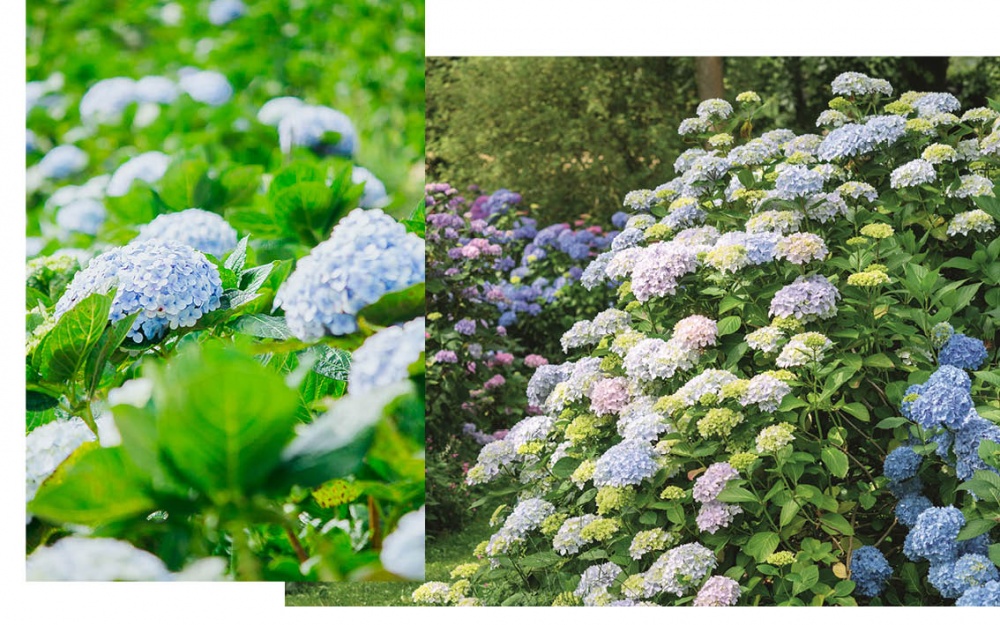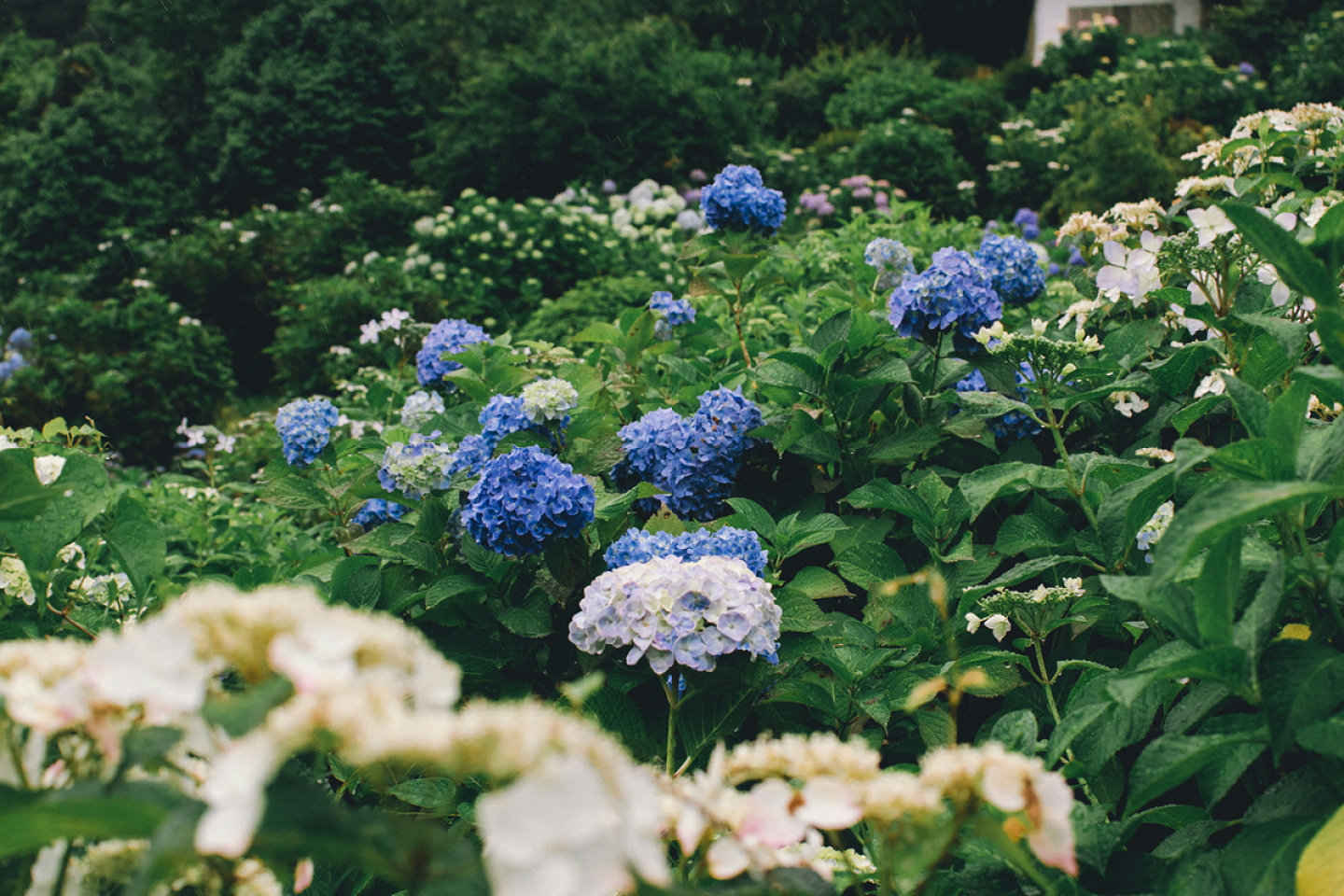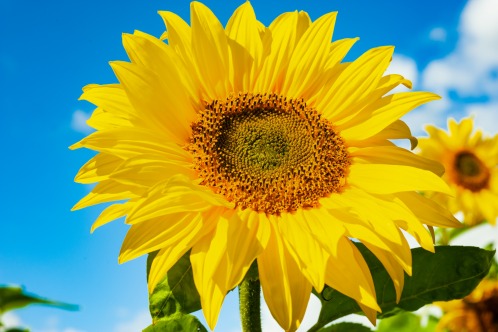How to: Buying, Planting and Growing Hydrangeas

In her book, Hydrangeas, expert Naomi Slade celebrates this fascinating plant and its reinstatement as the flower of choice for keen gardeners, florists and even wedding planners
Hydrangeas are usually offered for sale in pots – either to use decoratively in the house, or to plant out in the garden. The main difference is that plants for interior décor are usually in flower when they are sold, whereas garden shrubs may or may not be in flower and may even be dormant, depending on the time of year.
In either case, try and pick a plant that is as healthy and well-grown as possible. Check for dead stems and moss growth around the top of the pots, which may indicate a lack of prior care. Hydrangeas tend to be trouble-free, but it still pays to keep a weather-eye out for pests or diseases. By the time you buy your hydrangea, you will, ideally, have assessed your garden for climate, so use this knowledge to choose a species and cultivar which is likely to succeed.
Since hydrangeas are usually sold in pots, they can technically be planted into the garden at any time of the year – as long as the ground is not frozen and there isn’t a heatwave. But if they have been forced on in a greenhouse, they must be acclimatised to your local conditions first.
Most plants are best planted out when dormant or growing slowly. Hydrangeas planted out in autumn, winter and early spring will have a chance to settle into their new location and get their roots down before the weather warms up, and this will help them to establish and reduce drought-stress. If you do choose to plant out a shrub in summer, you must water it frequently and well.
First make sure that the location is suitable to the species and cultivar, in terms of shade and moisture. Water the plant thoroughly, preferably by immersing the container in a bucket, then dig a hole approximately twice the size of the rootball.
On poor soils mix some additional organic matter into the earth that you have dug out, and a handful of your preferred slow-release fertiliser can also be beneficial.
Position the hydrangea so that the compost that was in the pot is level with the surrounding ground, then back-fill the loose soil and firm it with your foot. Take care not to bury the stem in the process or it may rot. Water well and, ideally, mulch the area around the plant to reduce competition and retain moisture.

Hydrangeas can be grown very successfully in containers, and look great on a deck or either side of an entrance. It can also be a good way to cheat the local soil pH and get the flower colours you want. Indeed, in cold areas where the more tender macrophylla cultivars are marginal or otherwise impossible, container growing is the ideal way to enjoy them – displayed in a smart sleeve pot in summer, then lifted in its inner, utilitarian container, to be brought indoors to a frost-free place in winter.
The important thing is to pick a variety that doesn’t grow too large, and don’t skimp on the size of the pot you put it in. Use a good-quality soil-based compost that is designed for mature plants in permanent containers, and then you can tweak the pH if you want to. Make sure that the container drains really well, but pay close attention to watering, particularly in summer, as dry conditions can inhibit flower production. Depending on the ultimate size of the plant, you may need to repot your hydrangea every year or so, and, in any case, it is a good idea to remove some soil from the top of the pot and replace it with fresh on an annual basis. Feed and water regularly when in growth, prune as appropriate for the variety, and enjoy the show.
All plants require good nutrition to perform at their best, so for the biggest flowers and most healthy foliage it is a good idea to add a little nourishment, at least annually. The amount and frequency of food that is required will depend to a certain degree on variety and soil. Macrophylla types with their large leaves and often-heavy flowers tend to be pretty hungry, while others, including Hydrangea petiolaris and H. paniculata, are less so. If you have ‘perfect’ rich, moist, free-draining soil, you may very well get away with applying a good mulch around the roots of the plant in late autumn or winter – something like spent compost or well-rotted manure, spread around the base of the plant, but not touching the stem, is ideal.
Plants on poorer soils should be mulched and also given a balanced feed a couple of times a year, when in growth. The additional nitrogen will help the stems and leaves grow fast and strong, but avoid feeding in late summer and autumn as new shoots produced after that point will be more susceptible to frost damage.
Many feeds and fertilisers are available, included pelleted manure, liquid feeds and slow- release fertilisers. Some of these are organic and some will be plant-based rather than containing synthesised chemicals and animal products. You can, therefore, feed according to your preferences; a little research can pay dividends.
With their classic good looks and long-lasting flowers, hydrangeas are increasingly popular as house plants – indeed, many of the earlier cultivars that were bred in France aspired to perfection as an interior decoration, and who are we to argue?
Nursery and supermarket shelves are stacked with pretty varieties, each one an instant, growing bouquet, but unlike other bunches of flowers, they are not transient and disposable. So, to get the very best out of your hydrangea, you must treat it kindly. Site the plant in a part of your home that is cool, bright and airy, but does not get full sun. Avoid placing it near radiators or in very dry locations. Ensure the soil remains moist, but not wet and, since containerised plants rapidly run out of nutrients, feed it regularly during the growing season using a balanced fertiliser.
Most problems occur when the plant is kept too wet or dry. In damp conditions, fungal diseases such as botrytis may take hold; conversely, if the air and the soil are too dry, the plant may wilt, and dryness can also encourage red spider mite. If desired, you can plant your ‘indoor’ hydrangea outside, either in the ground or in a tub. But how well it does depends on care and breeding. Many glorious new plants are developed for the indoor- and cut-flower markets and their hardiness is not proven. Additionally, the plants that come foil-wrapped and in smart containers are hothouse- grown to be in magnificent bloom at the point of purchase, irrespective of the time of year. But with the right cultivar and a moderate climate, the plants can be trained to cope with the outdoors. Put it outside in summer shade, ensuring that temperatures don’t get too high or low, and that it doesn’t dry out. Once it is acclimatised, plant it out and water well and regularly, or leave in a tub to bring indoors in winter.










